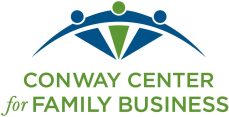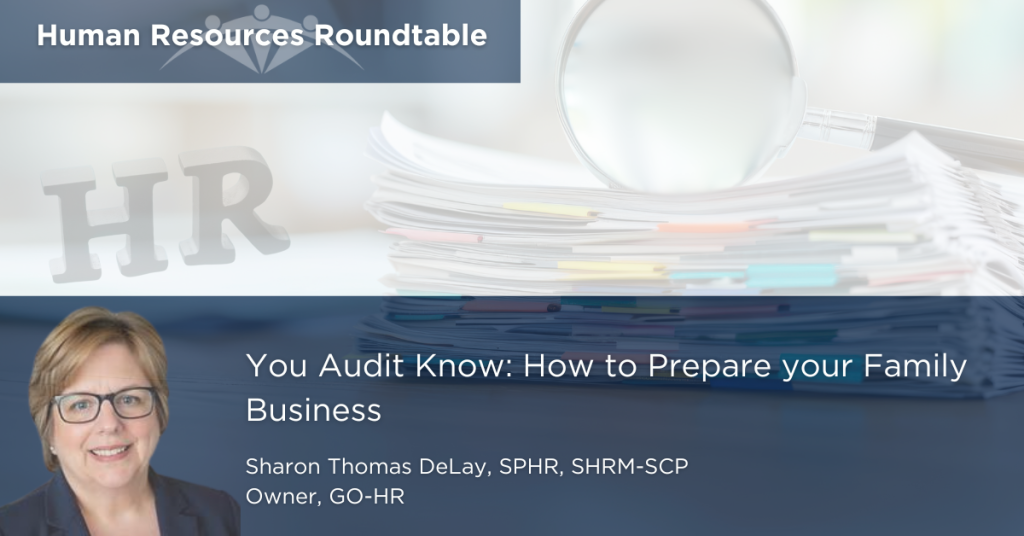The HR Audit was the focus of our most recent Human Resources Roundtable. Whether you’re in the role of human resources (HR) for your family business or you have an HR professional on staff, it’s important to understand that this role is equal parts risk management, employer protector, and people advocate. For this session we’ve focused on the risk manager role.
Any person new to any role should spend time getting to know the position – reviewing the procedures and policies in place, reviewing historical information, and understanding any goals and future plans. HR is no different, but for those of us in HR, getting to know a position usually begins with a series of audits of all things HR.
Most HR professionals begin with an audit of employee files and I-9 forms. This is HR 101 and important for several reasons. Reviewing employee files helps HR get to know employees, but it also helps HR to get a quick snapshot of hiring and onboarding processes based on the information collected or not collected in these files. An audit also allows HR to see if four important foundational documents exist that are a company’s first line of defense against may misunderstandings: signed offer letters, applications, signed job descriptions, and signed handbook acknowledgements. An audit of I-9 forms helps ensure that a company is consistently verifying that employees are eligible to work and collecting the necessary information to confirm this.
Next, an audit of the company’s current employee handbook allows your HR person to get a feel for policy and culture, as well as evaluate if you have the correct and compliant policies in place depending on the number of employees in your organization, as well as where they are working.
A walk-through of all company facilities should be on the audit checklist, as well. This will allow your HR person to confirm that the correct posters and mandatory postings are up-to-date and visible. During this walk-through, from a safety perspective, whether you have a separate safety person or not, HR can confirm that minimal safety items such as fire extinguishers, well-lit exit signs, and evacuation plans are available and accessible.
Reviewing payroll and benefits information is next on the audit checklist. Are correct deductions and deferrals in comparison to elections plan documents entered into the payroll system? Are employer matches for retirement plans calculating correctly? A good HR person knows that the employer has the ultimate responsibility for these things, so they don’t rely on third parties who may have incorrectly entered deductions or items as pre- or post-tax deductions or on systems calculating employer matches correctly. Humans and technology can be wrong, so a review of these items is not only a great way to learn about the company’s systems but also its benefits and the logistics of processing this information.
HR should also review the recruiting process. Is it equitable? Does it convey the company’s Employee Value Proposition from the earliest stages of the candidate attraction process? Is it meeting any state or municipality requirements regarding pay transparency and pay equity laws? Has your applicant tracking system been evaluation to ensure it is not disqualifying applicants based on any biases programmed into the AI program.
A review of position exemptions and pay (essentially a job analysis of your positions) will ensure that positions are classified correctly as exempt or non-exempt based on Fair Labor Standards Act requirements and Department of Labor standards. A review of compensation will help determine if there are pay inequity concerns that need to be addressed.
Finally, a review of the organization’s cyber security and technology policies will allow HR to ensure that not only are the right policies regarding employee acceptable use are in place, but also employees are notified regarding recording policies, use of company equipment and communication expectations within the scope of harassment avoidance and safe workplace considerations, and notification of no expectation of privacy when using company equipment and how company equipment can be used in context to the most current interpretation of the National Labor Relations Act.
Fees and fines in all these areas by federal and state agencies can add up quickly. A single I-9 penalty can be as low as around $300 for one first-time offense, while ERISA and EEO violations can quickly add up to hundreds of thousands and even millions of dollars.
While HR may be responsible for leading the audit charge, it’s important that the HR person in your family business works closely with the experts in these areas, including benefits experts, payroll specialists, and your other business partners and vendors. Doing so will ensure the best path forward for remediation and moving forward compliantly.
Nothing in this article should be construed as legal advice or guidance on benefits. Employers should work with their legal counsel and benefits partners to ensure they are legal and compliant in these areas.
The Conway Center Human Resources Roundtables are held quarterly and are facilitated by family business owner Sharon DeLay of GO-HR, a HR consultancy working with businesses across five areas: general HR, recruiting and onboarding, training and development, benefits and benefits consulting, and career and corporate outplacement.
These roundtables are free for all Conway Center members. The next HR Roundtable session will be held on Wednesday, January 29, 2025 - topic will be announced soon!


